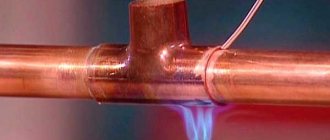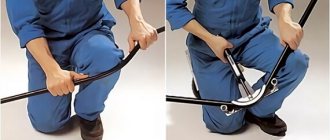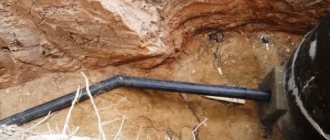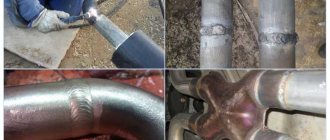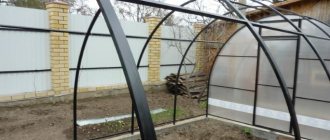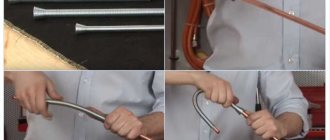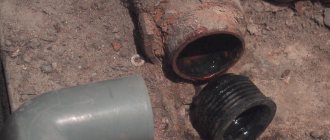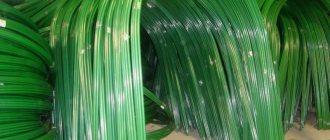Features of the use of copper
When it comes to organizing a heating or plumbing system, it’s hard to think of anything better than a copper pipe. This material has excellent contact with liquids of different temperatures, so it can be used equally well for both plumbing and heating. Features of copper products include:
- versatility: in addition to the listed areas of application, they include the installation of heated floors, as well as ventilation systems;
- copper products are used wherever liquid is used;
- resistance to rotting and corrosion: water is not subject to fungal growth and does not bloom;
- ductility: subject to certain temperatures, copper pipe can be bent perfectly;
- wide temperature range: inside the water supply you can use liquid with a temperature from -100 to +250 degrees.
Copper products are available in a wide variety of diameters.
If you install copper products on a water supply system, the water from it will not have a metallic taste. This is another feature of the material, which is complemented by pleasant decorative qualities: a copper pipeline can be decorated in a retro style.
What properties should a pipe have when bending?
The ability to bend is determined by the physical properties of a given material. Due to its plasticity, the workpiece can easily deform and also break at the bend, so when bending yourself, you should adhere to the set temperatures and do everything gradually.
Some of the material is offered to the buyer already bent in large coils
The main condition for bending is heating. Some thin-walled copper tubing can often be bent without the use of a torch or soldering station. A large number of copper products have thick walls, so heating is indispensable. Several conditions for bending products:
- temperature - copper cannot be heated above 1083 degrees: at such levels the material begins to melt, this deforms the product;
- the presence of a compensating element - sand, spring, other substances and objects can be used as a compensator;
- gradual implementation of the procedure.
In the absence of a compensator, the chances of deformation increase sharply. Sand or a spring inside a small-diameter product will prevent it from taking an irregular shape or allowing corrugation to occur.
The need to bend pipes during repair work: advantages
*
Bent pipes are common when carrying out installation and repair work of water supply and heating systems. Craftsmen often choose the bending method themselves, preferring it to standard welding. The need to bend metal arises when you need to get around a small area on a wall or floor with obstacles. In order not to use fittings, not to screw threads for connections, and also not to leave welds, you can use bending.
Before you bend a copper tube yourself, it is better to learn about the advantages of their use:
- reduction in labor intensity;
- improving the hydro-aerodynamic characteristics of pipe passages;
- reducing the amount of additional material;
- better sealing;
- attractive appearance.
The need for bending is due to the desire to give the pipeline strength and integrity
Bent copper piping does not have the risk of breakage and leakage that occurs when connecting pieces are used instead of bending. The bending point is not subject to friction, loads and other impact factors, so the chances of damage to the integrity are minimized.
Pipe bending technologies
Bent pipes are widely used in such industries as mechanical engineering, construction, chemical and petrochemical industries, and energy. Their use makes it possible to significantly reduce the number of welds and increase the tightness of pipelines.
As a rule, for bending pipes of small diameter, “cold bending” technology is used, in which the resulting pipe diameter is equal to the minimum value of the bend radius, measured along the center line of the pipe. A more effective method of bending pipes is “hot” bending technology. When using it, the material from which the pipe is made acquires greater plasticity, and, consequently, the risks of corrugation, cracks and other deformations are reduced.
When using both pipe bending technologies, the most important task is to ensure the absence of corrugations and equal pipe sections. In addition, it is necessary to take into account such a parameter as the depreciation of the pipe, which is determined by the type of material from which it is made.
Welded and seamless steel pipes, as well as similar products made of non-ferrous metals and alloys, can be bent. The correct bending radius allows you to ensure high quality work. The choice of this value depends on the material, diameter and wall thickness of the workpiece.
The use of filler helps prevent the formation of folds and corrugations in places where pipes are bent. Dry fine river sand or molten rosin acts in this capacity. When performing cold bending, the workpiece is tightly filled with sand and clogged with wooden plugs on both sides. The bend location is marked with chalk. The workpiece is installed in a pipe bender or machine. In this case, for non-seamless pipes, the weld seam should be on the side. The workpiece is bent manually or on a machine to the desired angle.
Depending on the scope of application, material and batch size, pipe bending can be carried out using manual, hydraulic and electric pipe benders, as well as CNC pipe bending equipment.
When installing pipelines made of various types of materials, its bending makes it possible to reduce the number of dismountable or welded connections that reduce the reliability of the pipeline. When carrying out pipe bending work, it is useful to know the permissible pipe bending radius, which ensures the safety and reliable operation of the pipeline system in accordance with the technical documentation.
Most often, bent pipes are made of steel and corrosion-resistant metals: stainless steel, copper, aluminum, brass; when installing household heating systems and water supply systems, products made of plastic and metal-plastic are bent. Methods for bending pipes along a radius vary depending on the material they are made of and can be done manually or electromechanically on special machines.
Rice. 1 Bending angles of copper pipes and brass products
Bend a copper pipe at home: a selection of methods
You can bend a copper tube without involving plumbers. There are proven, effective methods for this. Craftsmen use metal springs, river sand, bend pipes into a spiral, and also use a pipe bender.
Using a spring
The first thing you need to do is select a spring. To bend large-diameter copper pipes, you should choose a strong metal spring made of thick wire with frequent turns. Several features of bending with a spring:
- a metal spring is inserted inside;
- It is better that the length of the spring matches the length of the pipe;
- if the spring is shorter, a wire must be inserted into it so that it can be easily removed in the future;
- You can use a blowtorch or gas burner as a heating tool;
- the heating element is placed in place of the bend, as soon as the pipe changes color, it means it can be bent.
The metal spring acts as a compensating element for the copper material
*
The compensator in the form of a spring will not allow the product to deform. If you need to bend a thin tube, select a spring with a diameter larger than the product itself. The pipe is inserted inside the spring, then the procedure is repeated.
Application of sand
For manual bending, you can use river sand; it will be a good compensator. It is better to work in a spacious room or outdoors, as you will need a lot of space. A metal plug is useful as a material - it will serve as a plug for one end of the product. A piece of wood with the required diameter will act as a circle for bending. The procedure looks like this:
- The pipe is closed on one side with a plug.
- Sand is poured inside the product.
- The copper is heated using a lamp or torch.
- The product becomes plastic, so in order not to deform it, use rounded wood and make a bend on it.
The main thing is to follow the technology of bending the material and do everything according to the rules.
Using this simple but effective method, you can bend a copper tube yourself without a pipe bender.
Spiral method
Bending a spiral yourself is difficult. Here you can no longer limit yourself to using sand or a metal spring: another technique comes to the rescue. In order to bend the spiral you will need:
- rubber mallet;
- two supports;
- granular substance, such as sand: you can also use ice in the cold season;
- heating tool.
Due to its properties, copper material is flexible when heated.
The cavity is filled with sand or filled with ice.
You can also pre-fill the water inside and freeze it. Then the ends are placed on supports and the bending areas are heated. While the copper becomes ductile, it is given the desired shape using a mallet.
Pipe bending methods without factory equipment
In domestic conditions, there is often a need to bend pipe blanks when carrying out construction work or installing gas pipelines. At the same time, it is not economically feasible to spend financial resources on purchasing factory pipe benders for one-time operations; many use simple homemade devices for these purposes.
Steel pipes
Steel is a fairly rigid and durable material that is very difficult to deform; the main method of changing its configuration is bending in a heated state with a filler under simultaneous physical impact. For thin-walled stainless steel pipes, the following technology is used to obtain a long section with a small bend radius:
- Place the workpiece vertically, close it at one end with a stopper and pour very fine dry sand inside; after it is completely filled, insert the stopper on the other side.
- Find a pipe or low vertical pole of the required diameter and firmly fix the pipe end to its surface.
- Wrap the part around the pipe axis, turning the template or walking around it.
- After winding, the end is released and the curved part is removed from the template, the plugs are removed and sand is poured out.
Rice. 11 How to obtain the required bending radius of a copper pipe
Copper pipes
Copper is a softer material than steel; it is also convenient to bend when heated or with the help of sand poured inside. You can also use a household mandrel substitute for bending - a steel spring with dense thick coils and a cross-section slightly smaller than the workpiece. When carrying out work, the element is inserted inside and located at the point where deformation occurs, and after the necessary operations it is easily removed out. But it is much easier to bend copper pipes with a special spring pipe bender (these products can be purchased at the retail chain), which are effective on short routes and work due to the uniform distribution of the applied force on the surface. The spring device works as follows:
- The spring is placed over the pipe in the desired place, after which it is manually bent along with the pipe.
- With further bending, the spring is moved and bent at another point.
- Upon completion of the operation, the spring segment is easily removed without the use of auxiliary means.
Another popular material is aluminum, which is easier to bend when heated with a torch.
Rice. 12 How to bend pipes without an aluminum machine
Metal-plastic pipes
When bending metal-plastic pipes in households, an internal or external spring (conductor) is used. The technology for carrying out the work is similar to operations with a copper pipe; when bending, the permissible radius restrictions must be observed to avoid damage to the product.
Bending pipes using a pipe bender
*
A special tool helps in situations where traditional methods are powerless. A pipe bender is a tool that fixes one end of a pipe, bending it to a given diameter. There are no deformations during this type of work; everything goes quickly and clearly. Pipe benders can be steel, lever and electric. To bend a copper tube with a hand tool, you must perform the following steps:
- The required bending angle is selected: the parameters are indicated on the surface of the levers.
- One end of the workpiece is fixed.
- Flexion is performed.
A modern tool will help you make the necessary shape from copper in a matter of time.
This method is suitable for bending thin copper pipes, so if you have to work with a large diameter, it is better to use a hydraulic pipe bender. For large-scale and industrial work, electric tools are used.
Recommendations from experts and possible difficulties
When faced with flexible copper for the first time, any person at home may experience difficulties. Masters advise adhering to the following rules:
- use springs for bending foreign-made 6 mm thin copper pipes;
- if the coil is bent manually, you should be especially careful and smooth in your movements: sharp maneuvers will lead to severe deformation of the heated product;
- if the pipe being bent is made of annealed copper, it will take less time to bend it;
- It is allowed to reheat the product if the initial turn is performed incorrectly;
- It is impossible to bend large elements at home: an industrial tool is needed here.
Some craftsmen recommend using a lubricant when bending. This option is not suitable for beginners, as there is a risk of heating at high temperatures. To avoid difficulties, you should exercise extreme care and caution when working.
The technique of bending copper pipes will be useful when independently arranging communications. Graceful turns and bends will prevent loss of product integrity and also protect against leaks. Using the proposed methods will help you make a smooth and beautiful bend in a short time.
Methods for bending pipes of large and small diameters
Bending technologies depend on the plasticity of the pipe’s structural material, the thickness of its walls and the dimensions of the fittings (external and internal diameter). Moreover, all these parameters determine both the maximum bending radius and the type of bending process. Therefore, further in the text we will consider the processes of bending pipes from different structural materials.
Bending of non-ferrous metal pipes
For example, bending of pipes made of copper, aluminum and other non-ferrous metals with high malleability is carried out manually, in a cold way. After all, both copper and aluminum are distinguished by high thermal conductivity, and the high malleability of these metals allows pipes to be “bent” without heating.
Bending of non-ferrous metal pipes
And in most cases, the process of bending copper and aluminum is carried out as follows:
- The internal space is filled with water or sand.
- The ends of the pipe are closed with plugs.
- The body of the pipe is bent using a “caliber” - an arc with the required radius, or a palisade of pins in which one end of the pipe can be fixed.
As a result, it can be argued that the majority of copper and aluminum pipes are bent, essentially, using artisanal methods. Well, in industrial production they use a high-tech process of hydroforming the profile and pipe body.
Steel pipe bending
Bending of pipes made of stainless steel or structural steel is carried out both cold and hot.
Steel pipe bending
Moreover, hot bending is carried out using the same techniques as the deformation of reinforcement made of non-ferrous metals. There is no longer any need to fill a steel pipe with water or sand. The body of the steel reinforcement is simply heated at the bend until it turns red-orange, after which the pipe can be bent by hand. True, such a pipe can no longer be used in high-pressure pipelines . After all, after heating, the structure and strength characteristics of iron-carbon alloys will change.
A more advanced method is mechanical bending, which is implemented using roller machines. The pipe is deformed under the pressure of the upper roller, and the lower pair transports the entire measured section of the pipe through the deformation zone. Using this technology, you can even bend a pipe into a ring. Moreover, mechanical bending has virtually no effect on the strength characteristics of pipes. Therefore, this method is practiced when assembling both pipelines and metal structures.
Large-diameter steel pipes are cold bent by cutting deformation grooves in the body of the pipe (on the outer and inner sides of the bending radius). Moreover, after the reinforcement is deformed, these grooves will have to be welded. The strength characteristics of the deformable pipe, in this case, depend on the quality of the weld.
Bending of metal-plastic and structural polymer pipes
Bending of metal-plastic pipes
In this case, only cold bending methods are used. After all, polymer pipes and metal-plastic fittings melt at temperatures above 175 degrees Celsius. And natural plasticity is inherent in all polymers.
Moreover, bending polymer pipes requires less deforming force. For example, small-diameter pipes can be bent by hand, and the gauge or pattern that determines the bending radius is used only as a tool for monitoring the results of the process.
And even bending of large-diameter metal-plastic columns is carried out, in fact, manually. Only in this case, sand heated to 100-120 degrees Celsius must be poured into the inner part of the pipeline, which will change the plasticity of the reinforcement body. After all, polymers begin to “soften” already at 40-60 degrees Celsius, and metal-plastic, resistant to high temperatures, at 120-140 degrees.
That is, there are no problems with flexible polymer and composite pipes. Any reinforcement made from structural polymers can be bent by hand.
One of the activities of TPK Contact is pipe bending. We provide this service in Moscow and Moscow Region.
Pipe bending in production conditions is performed on manual, semi-automatic and automatic pipe bending machines. The choice of technology depends on the material, diameter and wall thickness of the workpiece, as well as the required accuracy and volume of work.
